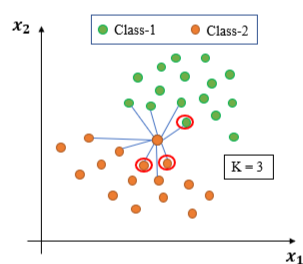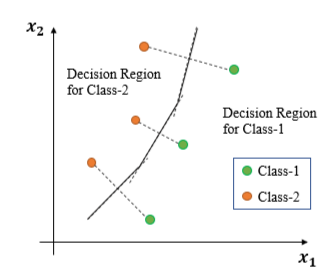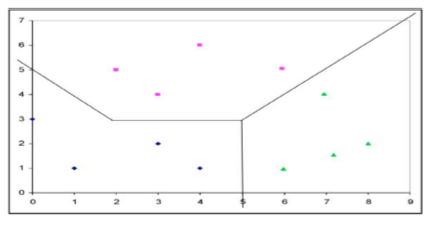
- by Team Handson
- July 14, 2022
KNN- Classifier
EUCLIDEAN DISTANCE–

- Consider the points in two-dimension. Each point in two-dimension can be represented by a vector of dimension two.






OTHER DISTANCE METRICS




There are other distance metric like: Mahala Nobis Distance, Bhattacharya Distance etc. These are used for advanced statistical pattern recognition tasks.

- K-NN Algorithm:
- All the training samples/ points are available beforehand.
- When a new test sample arrives calculate its distance from all training points.
- Choose K-nearest neighbors based on the distance calculated. Usually, the K is a positive odd integer and supplied by user.
- Assign the class label of the test sample based on majority. i.e. for a test sample if most number of neighbors among those K-Nearest Neighbors belong to one particular class-c, then assign the class label of test sample as c.
- Characteristics of K-NN Classifier:
It doesn’t create model based on the training patterns in advance. Rather, when a test instance comes for testing, runs the algorithm to get the class prediction of that particular testing instance. Hence, there is no learning in advance.
-Hence, k-NN classifier is also known as Lazy Learner.
K-NN Classifier: Decision Boundary–

- Boundary are the points those are equidistant between the points of Class-1 and Class-2
- Construct lines between closest pairs of points in different classes.
- Draw perpendicular bisectors. End bisectors at intersections.
- Note that locally the boundary is linear.
- Hence the decision boundary is piece-wise linear curve.

For multi-class classification also the same thing is done to find the decision boundary.
K-NN: Choosing the value of K–
Increasing the ‘K’ simplifies the decision boundary. Because majority voting implies less emphasis on individual points.

- However increasing the K also increases computational cost.
- Hence, choosing K is an optimization between how much simplified decision boundary we want vs. how much computational cost we can afford.
- Usually K = 5, 7, 9, 11 works fine for most practical problems.
Merits:
- K-NN Classifier often works very well for practical problems.
- It is very easy to implement, as there is no complex learning algorithm involved.
- Robust to Noisy Data.
Demerits:
- Choosing the value of K may not be straightforward. Often the same training samples are used for different values of K. But we choose the most suitable value of K based on minimum misclassification errors on test samples.
- Doesn’t work well for categorical attributes.
- Can encounter problem with sparse training data. (i.e. data points are located far away from each other)
- Can encounter problems in very high-dimensional spaces.
- Most points are at corners.
- Most points are at the edge of the space.
-This problem is known as Curse of Dimensionality and affect many other Machine Learning algorithms.






